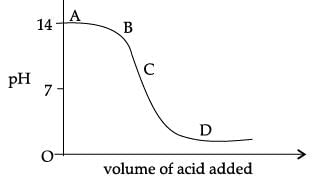Class 10 Exam > Class 10 Questions > The graph given below depicts a neutralizatio...
Start Learning for Free
The graph given below depicts a neutralization reaction (acid + alkali → salt + water).
The pH of a solution changes as we add excess of acid to an alkali.

Which letter denotes the area of the graph where both acid and salt are present?
The pH of a solution changes as we add excess of acid to an alkali.

Which letter denotes the area of the graph where both acid and salt are present?
- a)A
- b)B
- c)C
- d)D
Correct answer is option 'D'. Can you explain this answer?
Most Upvoted Answer
The graph given below depicts a neutralization reaction (acid + alkali...
C is correct answer bcuz it is a neutralization rxn

|
Explore Courses for Class 10 exam
|

|
Question Description
The graph given below depicts a neutralization reaction (acid + alkali → salt + water).The pH of a solution changes as we add excess of acid to an alkali.Which letter denotes the area of the graph where both acid and salt are present?a)Ab)Bc)Cd)DCorrect answer is option 'D'. Can you explain this answer? for Class 10 2025 is part of Class 10 preparation. The Question and answers have been prepared according to the Class 10 exam syllabus. Information about The graph given below depicts a neutralization reaction (acid + alkali → salt + water).The pH of a solution changes as we add excess of acid to an alkali.Which letter denotes the area of the graph where both acid and salt are present?a)Ab)Bc)Cd)DCorrect answer is option 'D'. Can you explain this answer? covers all topics & solutions for Class 10 2025 Exam. Find important definitions, questions, meanings, examples, exercises and tests below for The graph given below depicts a neutralization reaction (acid + alkali → salt + water).The pH of a solution changes as we add excess of acid to an alkali.Which letter denotes the area of the graph where both acid and salt are present?a)Ab)Bc)Cd)DCorrect answer is option 'D'. Can you explain this answer?.
The graph given below depicts a neutralization reaction (acid + alkali → salt + water).The pH of a solution changes as we add excess of acid to an alkali.Which letter denotes the area of the graph where both acid and salt are present?a)Ab)Bc)Cd)DCorrect answer is option 'D'. Can you explain this answer? for Class 10 2025 is part of Class 10 preparation. The Question and answers have been prepared according to the Class 10 exam syllabus. Information about The graph given below depicts a neutralization reaction (acid + alkali → salt + water).The pH of a solution changes as we add excess of acid to an alkali.Which letter denotes the area of the graph where both acid and salt are present?a)Ab)Bc)Cd)DCorrect answer is option 'D'. Can you explain this answer? covers all topics & solutions for Class 10 2025 Exam. Find important definitions, questions, meanings, examples, exercises and tests below for The graph given below depicts a neutralization reaction (acid + alkali → salt + water).The pH of a solution changes as we add excess of acid to an alkali.Which letter denotes the area of the graph where both acid and salt are present?a)Ab)Bc)Cd)DCorrect answer is option 'D'. Can you explain this answer?.
Solutions for The graph given below depicts a neutralization reaction (acid + alkali → salt + water).The pH of a solution changes as we add excess of acid to an alkali.Which letter denotes the area of the graph where both acid and salt are present?a)Ab)Bc)Cd)DCorrect answer is option 'D'. Can you explain this answer? in English & in Hindi are available as part of our courses for Class 10.
Download more important topics, notes, lectures and mock test series for Class 10 Exam by signing up for free.
Here you can find the meaning of The graph given below depicts a neutralization reaction (acid + alkali → salt + water).The pH of a solution changes as we add excess of acid to an alkali.Which letter denotes the area of the graph where both acid and salt are present?a)Ab)Bc)Cd)DCorrect answer is option 'D'. Can you explain this answer? defined & explained in the simplest way possible. Besides giving the explanation of
The graph given below depicts a neutralization reaction (acid + alkali → salt + water).The pH of a solution changes as we add excess of acid to an alkali.Which letter denotes the area of the graph where both acid and salt are present?a)Ab)Bc)Cd)DCorrect answer is option 'D'. Can you explain this answer?, a detailed solution for The graph given below depicts a neutralization reaction (acid + alkali → salt + water).The pH of a solution changes as we add excess of acid to an alkali.Which letter denotes the area of the graph where both acid and salt are present?a)Ab)Bc)Cd)DCorrect answer is option 'D'. Can you explain this answer? has been provided alongside types of The graph given below depicts a neutralization reaction (acid + alkali → salt + water).The pH of a solution changes as we add excess of acid to an alkali.Which letter denotes the area of the graph where both acid and salt are present?a)Ab)Bc)Cd)DCorrect answer is option 'D'. Can you explain this answer? theory, EduRev gives you an
ample number of questions to practice The graph given below depicts a neutralization reaction (acid + alkali → salt + water).The pH of a solution changes as we add excess of acid to an alkali.Which letter denotes the area of the graph where both acid and salt are present?a)Ab)Bc)Cd)DCorrect answer is option 'D'. Can you explain this answer? tests, examples and also practice Class 10 tests.

|
Explore Courses for Class 10 exam
|

|
Signup for Free!
Signup to see your scores go up within 7 days! Learn & Practice with 1000+ FREE Notes, Videos & Tests.


















